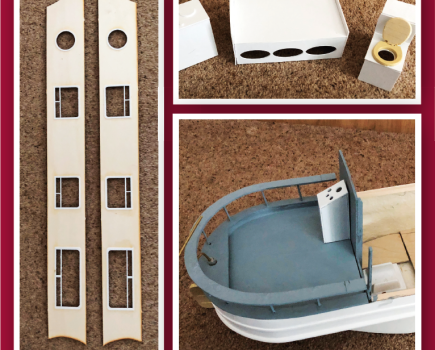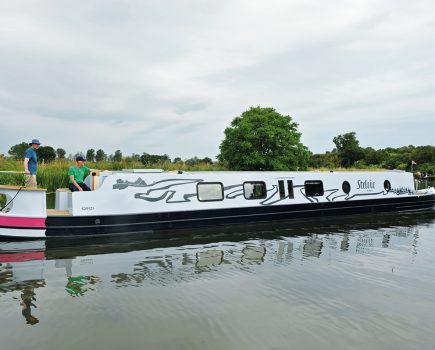Jane Ainsworth continues her 6000 mile Great Loop. This year she travels from Canada through the Great Lakes to Illinois

We’re now into our fourth year of looping – completing the 6,000-mile journey on canals, rivers, lakes and open sea of America’s Great Loop in our 38ft trawler.
Our latest trip on the eastern waterways took us from Britt, Ontario, where our boat had been stored over winter, through Lakes Huron and Michigan, and via Chicago to Peoria, Illinois.

We saw the most amazing contrasts of landscape, cityscape, small towns, beaches, sand dunes, and rocky wilderness with challenging weather along the way.
We had to wait until late May for the snow to melt in Canada to resume our travels. On the Great Lakes you have to take careful note of the local weather forecasts. Wave height and direction and wind strength determine the level of discomfort and danger, you are likely to experience with storms appearing out of nowhere.

The first part this year’s journey, from Britt to Killarney, involved 15 miles of open water and Ian’s main concern was to avoid a repetition of what has come to be known as The Lake Ontario Experience, our seven-hour crossing in strong winds and heavy swell. Between bouts of seasickness, I made plans to escape from boating.
A week after our return, the perfect day dawned and we set off on the small craft route, through Lake Huron’s North Channel, reputedly the most beautiful part of the Great Loop. It’s certainly the wildest and most isolated country that we’ve seen.

Until the mid-50s, the small fishing village of Killarney was a centre for the lumber trade. Now, it’s a popular venue for boaters and the Killarney Provincial Park attracts hikers and campers. Until 1962 there was no road access but it now has a road link with Sudbury.
We moored at the Sportsman’s Inn Marina. The next day Debbie, the receptionist, not only kindly gave us a lift to the start of the Chikanishing Trail, but insisted on lending us bug hats, without which we would have been prey to the many biting insects. She also made sure we knew what to do should we arouse a bear’s curiosity.

We discovered that hiking in Canada is not quite like hiking in Britain. Trail does not mean path, it simply means a straight line joining a series of waymarks, some of which are attached to trees and some painted on large slabs of rock. We were not quite so well equipped as we would have been at home and it was hard going but worth it for the stunning views of the lake and rocks.
From Killarney you pass into the channel, a narrow stretch of water between the mainland and the Manitoulin Islands. The pink granite gives way to limestone and there are a series of finger-like projections of land which form fiords. We explored one of them, Baie Fine, and anchored out at the head. There was a hiking trail over the ridge to Topaz Lake, and this was another challenge.

Further along the North Channel, at Blind River, we experienced a proper storm, fortunately about half an hour after safely tying up in the marina. We hadn’t realised it was coming and were alerted to it by the dockmaster, so spent the evening counting our blessings that we hadn’t been any later getting to the marina.
Blind River was our last stop in Canada. We crossed into US waters and anchored overnight at Harbour Island, a short distance from Drummond Island, where we would have to present ourselves to US Customs and Immigration.

Drummond Island is the most westerly of the Manitoulin Islands and is the only one which belongs to the USA and not Canada. It was a British outpost during the war of 1812, and was finally ceded to America in 1828.
It wasn’t until we were nearly there that it occurred to me that the officers might be interested in the contents of our fridge. I had once tried to import some top-quality, vacuum-packed, Richard Woodall Waberthwaite bacon into the USA for my son, and it had been seized and tossed unceremoniously into a bin with other proscribed articles. I wondered whether Canadian bacon would attract the same censure.

In the event, the two officers were very nice. We were allowed to keep the bacon and the Canadian Merlot, but then they spied the fruit bowl. The oranges, lemon and limes had to go, but we could keep the apples and bananas. I opened the fridge. ‘Is that a tomay-to?’ Indeed it was, and the tomatoes, a green pepper, lettuce, and anything from the onion family which sprouted leaves had to go too. Fortunately the marina had an ancient jeep that we were able to borrow, so we went to the grocery store to replenish our supplies.
After the isolation of the North Channel, we had a treat in store at Mackinac Island. In 1928, the island authorities decided to ban vehicles so transport on the island is by horse-drawn cart or bicycle. It’s a tourist destination and the main street was teeming with visitors who had arrived by ferry.

The Grand Hotel, situated on a hill overlooking Lake Huron and the Mackinac Straits, is aptly named, and although we couldn’t go for dinner, being unable to comply with the dress code which stipulated a jacket and tie for men, we went for the buffet lunch. The dining room, overlooking the lake and gardens, seats 700 people, and was full. But the waiter found us a table next to the window, and the food was superb.
The next day we cycled eight miles round the perimeter of the island, stopping occasionally to admire the crystal clear deep blue waters of Lake Huron, and the wild flowers growing up through the pebbles on the beach.
Rather reluctantly, we left Mackinac Island and passed under the five-mile Mackinac Bridge, which links the State of Michigan’s Upper and Lower Peninsulas, and separates Lake Huron from Lake Michigan.
But Lake Michigan’s eastern shore was another delight. We had a contact in Northport at the western end of Grand Traverse Bay and spent a few days there, enjoying wonderful American hospitality. This area of Michigan is famous for cherry growing and we took the bus from Northport to Traverse City to see the National Cherry Festival. As well as live music, aerobatic displays, fairground rides and a National Cherry Queen, there were stalls selling local foods and, of course, large bags of delicious fresh cherries.
In the middle of July, we had a family birthday to celebrate in Virginia. We left Carina in Northport and took three days driving through Michigan, Pennsylvania and West Virginia to Washington DC. Our route took us through the lovely Laurel Highlands of Pennsylvania, and gave us the opportunity to visit Fallingwater, Frank Lloyd Wright’s masterpiece built in 1935 for Mr and Mrs Edgar Kaufmann.
The house is built into the rocks overlooking Bear Run and overhangs two waterfalls. It embodies Wright’s philosophy of organic architecture, that buildings should be in harmony with their natural surroundings and his belief in nature’s power to renew the human spirit. Despite being built over 80 years ago, it is still breath-taking in its originality.
We returned to Northport and continued our journey down the eastern shore, which boasts 500 miles of spectacular sand dunes, the largest freshwater dunes in the world, formed from glacial activity 16,000 years ago. In parts they are covered with trees and grass, and elsewhere the golden sand is exposed.
At inlets along the coast, there are many attractive small towns and villages. Where we stayed, and the progress we made, was dependent on the wind and wave conditions on the lake. Although we’d become more confident over time, we still didn’t want to take any chances, and on one occasion, at Manistee, we left the dock and ventured out onto the lake, only to return to the shelter of the inlet half an hour later, to the wry amusement of the dockmaster. Fortunately there was space on the dock for us to stay another night.
The other factor which cramped our style was the mechanics of our ageing boat. It’s inevitable with a 38-year old boat that there will be a need for maintenance and repair, but it did seem on this trip as though Carina had decided to dump a disproportionate amount of catastrophe on us.
After spending time and money having a rattling prop shaft investigated and having the air-conditioning unit repaired, the engine water pump failed. We had to wait several days for a new one to arrive by special delivery and then have it fitted. But Whitehall was a pleasant place where we were able to cycle to the beach, and one evening there was a vintage car rally, when over 400 cars paraded in style down the main street.
We’d been recommended to visit Saugatuck, a favourite hang-out of Hemingway and other artists and now a popular tourist destination. We crossed the Kalamazoo River to Saugatuck village on the famous Chain Ferry, and had the best blueberry pancakes ever for breakfast, at Ida Red’s Cottage. Opposite Saugatuck village, facing Lake Michigan, is the extravagantly-named Baldhead Mountain. It’s really only a big sand-dune, but it’s still quite an effort to climb the 282 wooden steps to the top, to get the spectacular view of Saugatuck and Lake Kalamazoo.
Our goal of Chicago was getting closer. We crossed into Central Time at Michigan City (strangely, in Indiana). Moving into a different time-zone gave us a sense of our westward progress and how vast America is. We did a 30-mile hop across the bottom of Lake Michigan and couldn’t help noticing the clouds gathering as we approached Monroe Harbour, where Ian had booked us a buoy. The plan had been to take a water taxi and have a celebratory dinner at the Chicago Yacht Club.
But stuff happens. Monroe Harbour is open to the lake, and unusually, the wind was coming from the east, generating big waves inside the harbour. Then, although I managed to grab the buoy with the boat-hook, it didn’t have the usual moving attachment for threading a line through, and Carina’s deck was too high above the water to reach down. We ended up having to ask the harbourmaster for help – fortunately he came out straight away and attached our line. By this time the sky was dark and Carina was rolling and lurching in the waves. It soon began to thunder and pour with rain, and I had to lie down in a darkened room. Ian had to get his own dinner, and Chicago Yacht Club had to wait till we come back next year.
The next day we woke to calm waters and brilliant sunshine. We went through the Chicago Lock half a mile away, to enter the Sanitary and Ship Canal and follow its spectacular course through the city.
Beyond Chicago, it’s quite industrial as the canal leads into the Des Plaines River, and we encountered massive barges which obviously took precedence over our humble pleasure craft. These take precedence in the locks too, and we had some lengthy waits.
At McKinley Woods, the Kankakee River joins the Des Plaines to form the Illinois River and we were out into rural areas again, with some beautiful anchorages before we reached Peoria, where Carina is now stored. Next year, we have some sight-seeing to do in Chicago before continuing south towards the Mississippi and the Gulf of Mexico.
Image(s) provided by:
Archant







